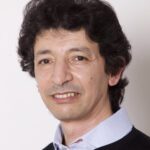Lien vers Pubmed [PMID] – 8622919
Lien vers HAL – pasteur-04036426
Lien DOI – 10.1073/pnas.93.8.3232
Proceedings of the National Academy of Sciences of the United States of America, 1996, 93 (8), pp.3232-3237. ⟨10.1073/pnas.93.8.3232⟩
The gene encoding human myosin VIIA is responsible for Usher syndrome type III (USH1B), a disease which associates profound congenital sensorineural deafness, vestibular dysfunction, and retinitis pigmentosa. The reconstituted cDNA sequence presented here predicts a 2215 amino acid protein with a typical unconventional myosin structure. This protein is expected to dimerize into a two-headed molecule. The C terminus of its tail shares homology with the membrane-binding domain of the band 4.1 protein superfamily. The gene consists of 48 coding exons. It encodes several alternatively spliced forms. In situ hybridization analysis in human embryos demonstrates that the myosin VIIA gene is expressed in the pigment epithelium and the photoreceptor cells of the retina, thus indicating that both cell types may be involved in the USH1B retinal degenerative process. In addition, the gene is expressed in the human embryonic cochlear and vestibular neuroepithelia. We suggest that deafness and vestibular dysfunction in USH1B patients result from a defect in the morphogenesis of the inner ear sensory cell stereocilia.

